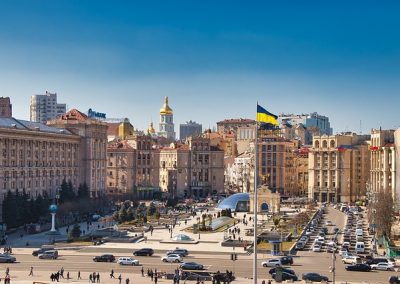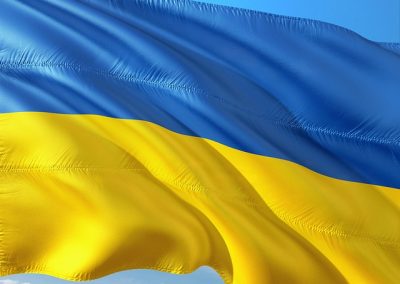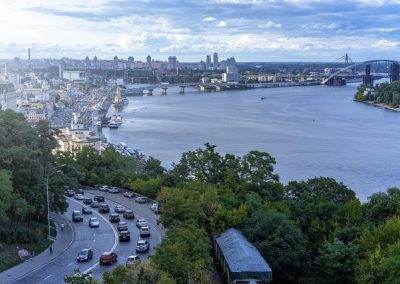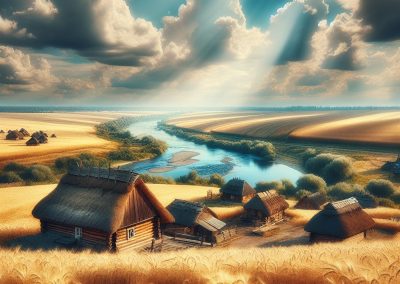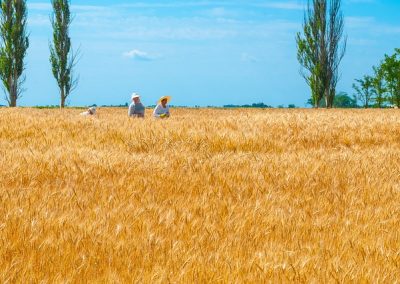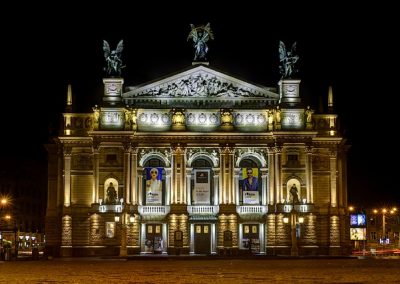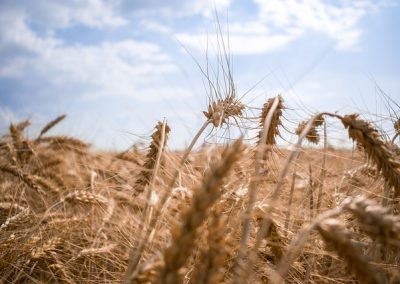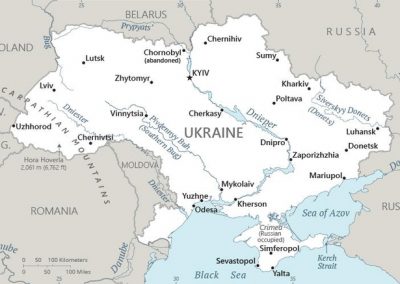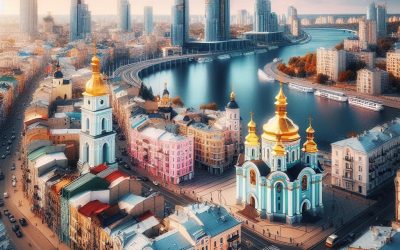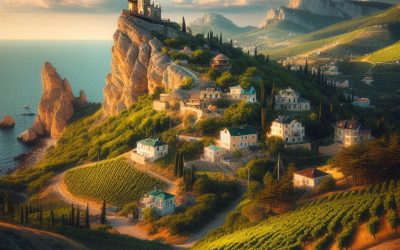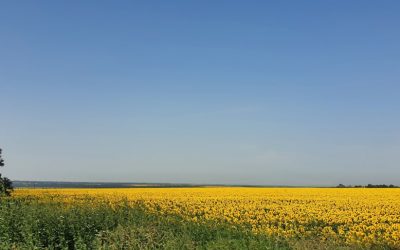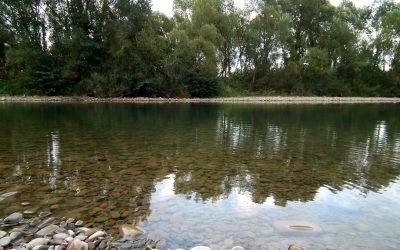Ukraine
(Ukrayina)

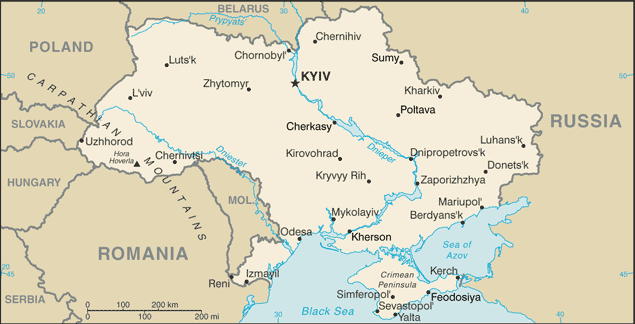
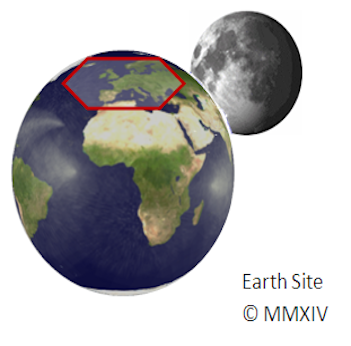
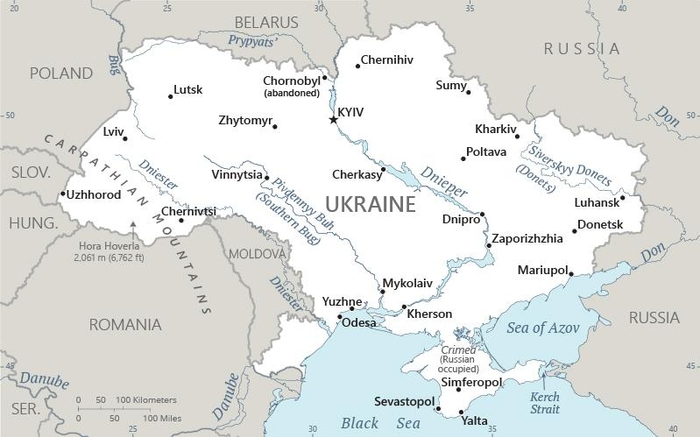
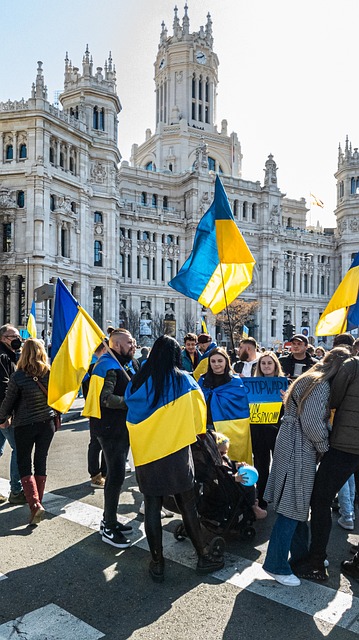
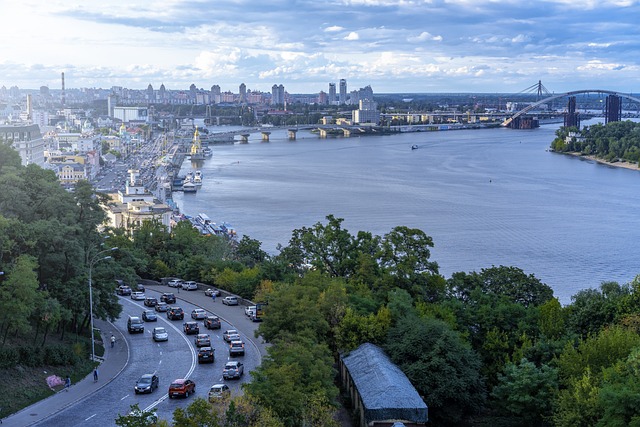
Capital: Kiev (Kyiv)
Population (Estimated July 2012): 44,854,065
Area: 603,628km2 or 233,062mi2
Currency: Hryvnya (UAH)
Official Language: Ukrainian
Political Information: Parliamentary Republic
Official Religion: No Official Religion (approximately 50.4% of the population is Ukrainian Orthodox – Kyiv Patriarchate, 26.1% are Ukrainian Orthodox – Moscow Patriarchate, 8% are Ukrainian Greek Catholic, 7% are Ukrainian Autocephalous Orthodox, 2.2% are Roman Catholic, 2.2% are Protestant, 0.6% are Jewish and 3.2% have other religious beliefs)
Highest Mountain: Hora Hoverla at 2,061m or 6,762ft
Time Zone (GMT/UTC): +2:00
Wildlife:
Counties/Provinces/States: 24 provinces (oblasti, singular – oblast’), 1 autonomous republic* (avtonomna respublika), and 2 municipalities (mista, singular – misto) with oblast status**; Cherkasy, Chernihiv, Chernivtsi, Crimea or Avtonomna Respublika Krym* (Simferopol’), Dnipropetrovs’k, Donets’k, Ivano-Frankivs’k, Kharkiv, Kherson, Khmel’nyts’kyy, Kirovohrad, Kyiv**, Kyiv, Luhans’k, L’viv, Mykolayiv, Odesa, Poltava, Rivne, Sevastopol’**, Sumy, Ternopil’, Vinnytsya, Volyn’ (Luts’k), Zakarpattya (Uzhhorod), Zaporizhzhya, Zhytomyr
Leaders: President Volodymyr Zelenskyy; Prime Minister Denys Shmyhal
Additional: Gained independence from the Soviet Union on the 24th of August 1991.
Ukraine
Ukraine, the largest country in Europe by land area, is a nation steeped in rich history and cultural diversity. Bordered by Belarus to the north, Russia to the northeast and east, and several Central European nations to the west, Ukraine serves as a bridge between East and West. Its capital, Kyiv, is one of the oldest cities in Eastern Europe, with a history that dates back over 1,400 years.
The country is known for its vast landscapes, ranging from the Carpathian Mountains in the west to the expansive steppes in the east, and its fertile plains that have earned it the moniker “the breadbasket of Europe.” The population of Ukraine is approximately 41 million people, making it one of the most populous countries in Europe. The nation is home to a variety of ethnic groups, with Ukrainians being the predominant group, followed by Russians, Belarusians, and Crimean Tatars.
This linguistic diversity reflects the complex historical influences that have shaped Ukraine’s identity over centuries.
Summary
- Ukraine is a country located in Eastern Europe, known for its rich history and diverse culture.
- The history of Ukraine is marked by periods of independence, foreign rule, and conflict, shaping the country’s identity and resilience.
- Ukraine’s geography includes diverse landscapes such as the Carpathian Mountains, fertile plains, and the Black Sea coast, with a continental climate.
- The economy of Ukraine is driven by agriculture, heavy industry, and natural resources, with a focus on steel production and energy.
- Ukrainian culture is influenced by its folklore, music, dance, and religious traditions, reflecting a strong sense of national identity.
History of Ukraine
The history of Ukraine is marked by a series of significant events that have shaped its national identity and territorial boundaries. The region has been inhabited since prehistoric times, with evidence of early human settlements dating back to the Paleolithic era. The establishment of Kievan Rus’ in the 9th century is often regarded as a pivotal moment in Ukrainian history.
This federation of Slavic tribes laid the foundation for Ukrainian statehood and culture, with Kyiv emerging as a major political and cultural centre. Throughout the centuries, Ukraine has experienced numerous invasions and occupations by foreign powers. The Mongol invasion in the 13th century devastated Kievan Rus’, leading to a period of fragmentation and decline.
In the 14th century, much of Ukraine fell under Polish-Lithuanian control, which introduced Catholicism and Western European influences. The Cossack Hetmanate emerged in the 17th century as a response to foreign domination, asserting a degree of autonomy and fostering a sense of national identity. However, by the late 18th century, much of Ukraine was absorbed into the Russian Empire, leading to further cultural suppression and Russification.
The 20th century was particularly tumultuous for Ukraine. Following the Russian Revolution in 1917, Ukraine briefly declared independence but was soon engulfed in civil war and subsequently became part of the Soviet Union. The Holodomor, a man-made famine in the early 1930s, resulted in the deaths of millions of Ukrainians and remains a deeply painful chapter in the nation’s history.
Ukraine regained independence in 1991 following the dissolution of the Soviet Union, marking a new era for the country as it sought to establish its sovereignty and navigate its post-Soviet identity.
Holodomor
Holodomor, a term derived from the Ukrainian words “holod” (hunger) and “moryty” (to kill), refers to the catastrophic famine that struck Soviet Ukraine between 1932 and 1933. This man-made disaster resulted in the deaths of millions of Ukrainians, with estimates ranging from 3.5 to 7 million people. The famine was not merely a natural occurrence; it was exacerbated by the policies of the Soviet government under Joseph Stalin, which aimed to enforce collectivisation and suppress Ukrainian nationalism.
The Holodomor is often regarded as a genocide against the Ukrainian people, as it was characterised by the deliberate actions of the state to extract grain and resources from Ukraine while denying food aid to its starving population. The famine’s origins can be traced back to the Soviet regime’s aggressive agricultural policies, which sought to consolidate individual farms into collective ones. This transition was met with resistance from many Ukrainian peasants, who were unwilling to relinquish their land and livestock.
In response, the government implemented harsh measures, including confiscating grain and other foodstuffs, which left rural communities destitute. The situation was further compounded by a series of poor harvests and adverse weather conditions, but it was the state’s ruthless enforcement of grain quotas that ultimately led to widespread starvation. The Holodomor remains a deeply painful chapter in Ukrainian history, symbolising the struggle for identity and autonomy in the face of oppressive governance.
The recognition of Holodomor as a genocide has been a contentious issue both within Ukraine and internationally. For decades, the Soviet government denied that a famine had occurred, portraying reports of starvation as exaggerated or fabricated by hostile foreign powers. This denial persisted even after Ukraine gained independence in 1991, with some factions within Russia continuing to downplay or dismiss the events as a natural disaster rather than a deliberate act of genocide.
Such denialism has often been rooted in political motivations, as acknowledging Holodomor as genocide would implicate the Soviet regime in crimes against humanity. In contrast, many countries and international organisations have taken steps to formally recognise Holodomor as a genocide. In 2006, Ukraine’s parliament passed a law declaring Holodomor a genocide against the Ukrainian people, and numerous nations have followed suit by recognising it officially.
This recognition is crucial not only for historical accuracy but also for acknowledging the suffering endured by millions. It serves as an important step towards healing and reconciliation for survivors and their descendants, allowing them to confront their past while advocating for justice and remembrance.
Geography and Climate of Ukraine
Ukraine’s geography is characterised by its diverse landscapes, which include vast plains, rolling hills, mountains, and rivers. The Carpathian Mountains in the west are home to some of the highest peaks in Eastern Europe, providing opportunities for hiking and winter sports. The Crimean Peninsula, located on the northern coast of the Black Sea, boasts stunning coastal scenery and unique ecosystems.
The Dnieper River, one of Europe’s major rivers, flows through the heart of Ukraine, serving as a vital waterway for trade and transportation. The climate of Ukraine varies significantly across its regions. The western part experiences a humid continental climate with warm summers and cold winters, while the southern regions near the Black Sea enjoy a more temperate climate with milder winters.
The eastern part of Ukraine has a more continental climate with greater temperature extremes. This climatic diversity supports a wide range of agricultural activities, making Ukraine one of the world’s leading producers of grains and other crops.
Economy and Industry in Ukraine
Ukraine’s economy is diverse and resource-rich, with agriculture playing a central role. The country’s fertile soil, known as chernozem or black earth, is among the most productive in the world. Ukraine is one of the largest exporters of grain globally, particularly wheat and corn.
In addition to agriculture, Ukraine has a well-developed industrial sector that includes heavy machinery manufacturing, metallurgy, and chemical production. The country is also known for its aerospace industry and has a long-standing tradition of producing aircraft and space technology. Despite its potential, Ukraine’s economy has faced significant challenges since gaining independence.
Political instability, corruption, and external conflicts have hindered economic growth and foreign investment. The annexation of Crimea by Russia in 2014 and ongoing conflict in Eastern Ukraine have further complicated economic recovery efforts. However, recent reforms aimed at improving governance and transparency have begun to yield positive results, attracting renewed interest from international investors.
Ukrainian Culture and Traditions
Ukrainian culture is a vibrant tapestry woven from centuries of history, folklore, and artistic expression. Traditional music plays an essential role in Ukrainian culture, with folk songs often accompanied by instruments such as the bandura and kobza. Dance is also an integral part of cultural celebrations; traditional dances like the hopak are performed during festivals and gatherings.
The rich oral tradition includes epic poetry known as “duma,” which recounts historical events and heroic tales. Festivals are an important aspect of Ukrainian life, reflecting both religious and seasonal themes. One of the most significant celebrations is Ivan Kupala Night, which marks the summer solstice with rituals involving fire and water to honour fertility and love.
Christmas and Easter are celebrated with unique customs that vary by region; for instance, Easter eggs (pysanky) are intricately decorated using traditional techniques that have been passed down through generations. These cultural practices not only preserve Ukrainian heritage but also foster community bonds.
Ukrainian Cuisine and Food
Ukrainian cuisine is hearty and diverse, reflecting the agricultural abundance of the country. One of the most iconic dishes is borscht, a beetroot soup that can be served hot or cold and often includes ingredients such as cabbage, potatoes, carrots, and meat. It is typically garnished with sour cream and fresh herbs.
Another staple is varenyky (dumplings), which can be filled with various ingredients ranging from potatoes to cherries and are often served with sour cream or fried onions. Bread holds a special place in Ukrainian culture; it is often referred to as “the staff of life.” Traditional rye bread (palyanytsya) is commonly served at meals and during celebrations. Additionally, Ukrainian cuisine features an array of pickled vegetables, meats such as salo (cured pork fat), and dairy products like cheese and sour cream.
Meals are often accompanied by horilka (vodka), which plays a significant role in social gatherings.
Political Situation in Ukraine
The political landscape in Ukraine has been marked by significant upheaval since independence. The Orange Revolution in 2004 was a pivotal moment when mass protests erupted against electoral fraud during presidential elections. This movement led to a re-run of the elections and ultimately brought Viktor Yushchenko to power.
However, political divisions persisted between pro-European western regions and pro-Russian eastern areas. The situation escalated dramatically in 2014 when protests against President Viktor Yanukovych’s decision to suspend an association agreement with the European Union led to his ousting. This period also saw Russia’s annexation of Crimea and the outbreak of conflict in Eastern Ukraine involving Russian-backed separatists.
The ongoing war has resulted in thousands of casualties and has displaced millions from their homes. International efforts to mediate peace have been complicated by geopolitical tensions between Russia and Western nations.
Ukraine: A Country at a Crossroads
Ukraine, the largest country in Europe by land area, is a nation steeped in a rich tapestry of history and culture. Geographically, it is strategically positioned at the crossroads of Eastern Europe, bordered by Belarus to the north, Russia to the northeast and east, and the Black Sea to the south. This location has made Ukraine a focal point for various civilisations throughout history, from the ancient Scythians and Sarmatians to the powerful Kyivan Rus, which laid the foundations for modern Ukrainian identity.
The Carpathian Mountains in the west and the vast steppes in the east contribute to its diverse landscape, which has been both a blessing and a curse, providing fertile land for agriculture while also making it a target for invasions. Historically, Ukraine has experienced a tumultuous past marked by periods of independence and foreign domination. The Mongol invasion in the 13th century, followed by centuries of Polish-Lithuanian and Russian rule, shaped its national identity.
The 20th century brought further upheaval, with Ukraine suffering immensely during the Holodomor, a man-made famine in the 1930s that claimed millions of lives. Following World War II, Ukraine became one of the founding republics of the Soviet Union, enduring significant industrialisation and urbanisation but also repression. The dissolution of the Soviet Union in 1991 marked a pivotal moment in Ukraine’s history, as it declared independence and sought to forge its own path in a rapidly changing world.
Summary
- Ukraine has a rich history and diverse geography, with influences from various empires and cultures.
- Political challenges and divisions within Ukraine have led to instability and conflict, particularly in the ongoing conflict in with Russia.
- Ukraine faces economic struggles but also has opportunities for growth, particularly in its agricultural and IT sectors.
- Ukraine’s relationship with Russia and the European Union is complex, with tensions and competing influences.
- Ukraine is culturally and linguistically diverse, with a mix of Ukrainian, Russian, and other ethnic groups.
Ukraine’s role in international relations and geopolitics
Ukraine occupies a pivotal position in international relations due to its geographical location and historical ties with both Western Europe and Russia. As tensions between NATO and Russia have escalated in recent years, Ukraine has become increasingly central to discussions about security in Eastern Europe. The country’s aspirations for NATO membership have been met with mixed responses from member states; while some support Ukraine’s bid for closer integration into Western security structures, others remain cautious about provoking further Russian aggression.
Moreover, Ukraine’s relationship with international organisations such as the United Nations and the Organisation for Security and Co-operation in Europe (OSCE) underscores its commitment to multilateralism. By engaging with these bodies, Ukraine seeks to garner support for its territorial integrity while advocating for human rights and democratic governance. The ongoing conflict has drawn attention from global powers, prompting discussions about sanctions against Russia and humanitarian assistance for affected populations.
As geopolitical dynamics continue to evolve, Ukraine’s role as a key player in regional stability remains critical.
The future of Ukraine: prospects and challenges
Looking ahead, Ukraine faces both significant prospects and formidable challenges as it navigates its path forward. The potential for economic growth exists through continued reforms aimed at combating corruption and enhancing transparency within government institutions. Strengthening ties with the European Union could provide access to vital markets and investment opportunities that would bolster economic resilience.
Additionally, harnessing its technological capabilities could position Ukraine as a leader in innovation within Eastern Europe. However, these prospects are tempered by ongoing political instability and external threats. The unresolved conflict in Eastern Ukraine poses a significant barrier to national unity and development efforts.
Furthermore, internal divisions based on language and culture may hinder progress towards a cohesive national identity that embraces diversity while fostering solidarity. As Ukraine strives for stability amidst these challenges, the international community’s support will be crucial in ensuring that it can realise its aspirations for democracy, prosperity, and peace on its own terms.
Tourism in Ukraine
Tourism in Ukraine offers a wealth of experiences for visitors seeking to explore its rich heritage and natural beauty. Kyiv stands out as a major destination with its stunning architecture, including Saint Sophia Cathedral and Kyiv Pechersk Lavra (Monastery of the Caves), both UNESCO World Heritage Sites. The city’s vibrant arts scene includes theatres, galleries, and music festivals that showcase contemporary Ukrainian culture.
Beyond Kyiv, Lviv enchants visitors with its well-preserved medieval architecture and charming cobblestone streets. Known for its coffee culture and vibrant nightlife, Lviv has become increasingly popular among tourists seeking an authentic experience. The Carpathian Mountains attract outdoor enthusiasts year-round for hiking in summer and skiing in winter.
Odesa on the Black Sea coast offers beautiful beaches alongside a rich cultural scene influenced by its history as a major port city. Visitors can explore its famous Potemkin Stairs or enjoy performances at the Odesa Opera House. As Ukraine continues to develop its tourism infrastructure amidst ongoing challenges, it remains an intriguing destination for those looking to discover its unique blend of history, culture, and natural beauty.
FAQs
What is the capital of Ukraine?
The capital of Ukraine is Kyiv.
What is the population of Ukraine?
As of 2021, the population of Ukraine is estimated to be around 41 million people.
What is the official language of Ukraine?
The official language of Ukraine is Ukrainian.
What is the currency of Ukraine?
The currency of Ukraine is the Ukrainian hryvnia (UAH).
What are some popular tourist attractions in Ukraine?
Some popular tourist attractions in Ukraine include the city of Lviv, the Carpathian Mountains, the historic city of Chernivtsi, and the coastal city of Odesa.
What is the climate like in Ukraine?
Ukraine has a temperate continental climate, with hot summers and cold winters. The climate can vary depending on the region, with more moderate temperatures in the coastal areas and mountainous regions.
What are some traditional Ukrainian dishes?
Traditional Ukrainian dishes include borscht (beet soup), varenyky (dumplings), holubtsi (stuffed cabbage rolls), and salo (cured pork fat).
What are some major industries in Ukraine?
Some major industries in Ukraine include agriculture, manufacturing, energy production, and technology. Ukraine is also known for its rich natural resources, including coal, iron ore, and natural gas.
Climate Zones of Ukraine: Different Climate Regions Of Ukraine
Ukraine, a country located in Eastern Europe, is characterised by a diverse array of climate zones that reflect its geographical position and topographical variations. Spanning from the temperate continental climate in the east to the more maritime influences in the west, Ukraine‘s climate is shaped by a multitude of factors, including latitude, altitude, and proximity to bodies of water. This climatic diversity not only influences the natural environment but also plays a significant role in the agricultural practices, economic activities, and lifestyle of its inhabitants. The climate zones of Ukraine can be broadly categorised into several distinct types, each with its own unique characteristics. These include the continental climate of Eastern Ukraine, the maritime climate of Western Ukraine, the Mediterranean climate of Southern Ukraine, the mountain climate of the Carpathian region, the steppe climate of Central Ukraine, and the subarctic climate of Northern Ukraine. Understanding these various climates is essential for appreciating the ecological richness of the country and the adaptations of its flora and fauna. Furthermore, this climatic diversity has implications for human activities, including agriculture, industry, and tourism, making it a vital aspect of Ukraine’s identity. Summary Ukraine has a diverse range of climate zones, each with its own unique characteristics and influences. Eastern Ukraine experiences a continental climate, with hot summers and cold winters, influenced by its inland location. Western Ukraine has a maritime climate, with mild winters and relatively cool summers, influenced by its proximity to the Black Sea. Southern Ukraine enjoys a Mediterranean climate, with hot, dry summers and mild, wet winters, influenced by its southern location and proximity to the Black Sea. The...
Political Boundaries of Ukraine: Provinces, Districts, or Historical Boundaries.
Ukraine, a nation steeped in a rich tapestry of history and culture, occupies a strategic position in Eastern Europe. Its political boundaries have been shaped by centuries of conflict, shifting allegiances, and the aspirations of its people. The current borders of Ukraine were established following the dissolution of the Soviet Union in 1991, marking a significant moment in the country’s quest for sovereignty and independence. These boundaries not only delineate the geographical extent of the state but also encapsulate the diverse ethnic, linguistic, and cultural identities that exist within its confines. The political boundaries of Ukraine are not merely lines on a map; they represent the culmination of historical events, territorial disputes, and the aspirations of various groups. The complexity of these boundaries is further exacerbated by ongoing geopolitical tensions, particularly with Russia, which has sought to assert its influence over Ukraine through annexation and military intervention. Understanding Ukraine’s political boundaries requires an examination of both the historical context that shaped them and the contemporary challenges that arise from their existence. Summary Ukraine’s political boundaries are complex and have evolved over time, influenced by historical, geographical, and cultural factors. The administrative divisions of Ukraine are divided into provinces, each with its own unique characteristics and governance structure. Within the provinces, there are districts that further subdivide the territory and play a role in local governance and administration. The historical boundaries of Ukraine have had a significant impact on the modern political structure, shaping the country’s identity and political landscape. The debate over Ukraine’s political boundaries continues to be a contentious issue, with various stakeholders advocating for different approaches to...
Natural Resources of Ukraine: Where Natural Resources are Located in Ukraine
Ukraine is endowed with a wealth of natural resources that play a pivotal role in its economy and the livelihoods of its citizens. The country is often referred to as the “breadbasket of Europe” due to its fertile soil and extensive agricultural lands. This agricultural prowess is complemented by a diverse array of mineral resources, energy reserves, and rich biodiversity. The strategic location of Ukraine, situated at the crossroads of Europe and Asia, further enhances its significance in the global resource landscape. The interplay between these natural resources and the socio-economic fabric of Ukraine is profound, influencing everything from local economies to international trade dynamics. The management and sustainable utilisation of these resources are critical, especially in light of environmental challenges and geopolitical tensions. Ukraine’s natural wealth has historically attracted both domestic and foreign interest, leading to various exploitation practices that have raised concerns about sustainability and environmental degradation. As the country navigates its path towards economic development, the balance between resource extraction and conservation becomes increasingly important. Understanding the distribution and significance of these resources is essential for formulating effective policies that promote sustainable development while ensuring economic growth. Summary Ukraine is rich in natural resources, including agricultural, mineral, energy, water, forest, wildlife, and biodiversity resources. The agricultural resources in Ukraine are mainly located in the fertile plains of the country, particularly in the central and southern regions. Ukraine has a diverse distribution of mineral resources, with significant deposits of iron ore, coal, natural gas, and oil. The exploration of energy resources in Ukraine is focused on increasing domestic production of oil and gas, as well as developing...
Terrain and Topography of Ukraine: mountains, valleys, and plains.
Ukraine, the largest country in Europe by land area, boasts a remarkably diverse terrain and topography that reflects its rich geological history and climatic variations. Spanning approximately 603,500 square kilometres, the country is characterised by a mosaic of landscapes, ranging from the rugged Carpathian Mountains in the west to the expansive steppes in the east. This geographical diversity not only shapes the natural beauty of Ukraine but also influences its agricultural practices, biodiversity, and cultural heritage. The country’s topography is marked by a series of distinct regions, each with its own unique features. The interplay between mountains, rivers, plains, and plateaus creates a dynamic environment that has been shaped over millennia by natural forces such as erosion, glaciation, and sedimentation. Understanding Ukraine’s terrain is essential for appreciating its ecological richness and the ways in which its landscapes have influenced human settlement and activity throughout history. Summary Ukraine’s terrain and topography are diverse and varied, ranging from mountains to plains and coastal lowlands. The Carpathian Mountains are home to Ukraine’s highest peaks, offering stunning natural beauty and opportunities for outdoor activities. The Dnieper River Valley is known as Ukraine’s breadbasket, providing fertile land for agriculture and a vital source of water and transportation. The Crimean Peninsula is a unique topographical feature, with its own distinct landscape and climate, including mountains, plateaus, and coastal areas. The Ukrainian Steppe is characterized by vast plains and grasslands, playing a significant role in the country’s history and culture. The Carpathian Mountains: Ukraine’s Highest Peaks The Carpathian Mountains, which stretch across several Central and Eastern European countries, form a significant part of Ukraine’s western border....
History of Ukraine
The history of Ukraine is deeply rooted in the early settlement patterns that emerged in the region thousands of years ago. Archaeological evidence suggests that the territory now known as Ukraine was inhabited as far back as the Paleolithic era, with various tribes and cultures leaving their mark on the land. The Trypillian culture, which flourished between 5500 and 2750 BCE, is particularly notable for its advanced agricultural practices and large settlements. These early inhabitants developed sophisticated pottery and engaged in trade with neighbouring regions, laying the groundwork for future civilisations. As time progressed, the area saw the arrival of various nomadic tribes, including the Scythians and Sarmatians, who roamed the steppes and contributed to the cultural tapestry of Ukraine. The fertile lands attracted these groups, who relied on both agriculture and animal husbandry. The interactions between these nomadic tribes and settled agricultural communities fostered a dynamic exchange of ideas, technologies, and customs. This early period set the stage for the emergence of more complex societies, ultimately leading to the formation of powerful states in the region. Summary The early settlement of Ukraine dates back to ancient times, with evidence of human habitation as early as 32,000 BC. The Kievan Rus‘ period marked a golden age for Ukraine, with the city of Kiev becoming a major center of trade, culture, and Christianity. The Mongol invasion in the 13th century led to the rise of the Cossacks, who played a significant role in Ukrainian history and culture. The partitions of Poland in the 18th century and the emergence of Ukrainian nationalism set the stage for future struggles for independence. Ukraine...
Population Density of Ukraine
Population density, defined as the number of individuals living per unit area, serves as a critical indicator of demographic trends and socio-economic conditions within a country. In Ukraine, a nation with a rich history and diverse geography, population density varies significantly across its regions. As of the latest estimates, Ukraine has a population density of approximately 73 people per square kilometre, which places it in the mid-range compared to other European countries. This figure, however, masks considerable disparities between urban and rural areas, as well as among different regions of the country. The implications of population density in Ukraine are profound, influencing everything from economic development to social services and environmental sustainability. Urban centres like Kyiv, Kharkiv, and Odesa exhibit high population densities, leading to vibrant economic activities but also presenting challenges such as congestion and pollution. Conversely, rural areas often face depopulation and underdevelopment, raising questions about resource allocation and infrastructure investment. Understanding the dynamics of population density in Ukraine is essential for policymakers, urban planners, and social scientists alike, as it provides insights into the country’s demographic challenges and opportunities. Summary Ukraine has a population density of 75 people per square kilometre, making it one of the most densely populated countries in Europe. Factors affecting population density in Ukraine include historical migration patterns, economic opportunities, and natural resources. Urban areas in Ukraine have higher population density compared to rural areas, with over two-thirds of the population living in cities. High population density in Ukraine puts pressure on infrastructure and resources, leading to challenges in providing adequate services and amenities. Historical trends show fluctuations in population density, with...
Cultural or Historical Sites of Ukraine: Important Cultural Landmarks or Historical Sites In Ukraine
Ukraine, a nation steeped in a rich tapestry of history and culture, boasts an array of cultural and historical sites that reflect its diverse heritage. From ancient ruins to grand architectural marvels, the country is a treasure trove for those interested in exploring the past. The geographical location of Ukraine, situated at the crossroads of Europe and Asia, has made it a melting pot of various cultures, traditions, and influences over the centuries. This unique blend is evident in its historical landmarks, which tell the story of the nation’s evolution through time. The significance of these sites extends beyond mere aesthetics; they embody the spirit and resilience of the Ukrainian people. Many of these locations have witnessed pivotal moments in history, serving as silent witnesses to the trials and triumphs of the nation. As Ukraine continues to navigate its path in the modern world, these cultural and historical sites remain vital in preserving national identity and fostering a sense of pride among its citizens. The following sections will delve into some of the most notable sites that encapsulate Ukraine’s rich heritage, each with its own unique story to tell. Summary Ukraine is home to a wealth of cultural and historical sites, each with its own unique story to tell. The country boasts several UNESCO World Heritage Sites, showcasing its rich and diverse heritage. Kyiv Pechersk Lavra is a significant religious site, revered as Ukraine’s holiest monastery. Lviv Old Town is a stunning architectural gem, recognised by UNESCO for its historical significance and beauty. Chernivtsi University stands as a remarkable example of European architecture, drawing visitors from around the world....
Kyiv City, Ukraine
Kyiv City, also known as Kiev, is the capital and largest city of Ukraine. It is located in the north-central part of the country along the Dnieper River. With a population of over 3 million people, Kyiv City is not only the political and administrative center of Ukraine but also its cultural and economic hub. The city has a rich history that dates back centuries and is known for its stunning architecture, vibrant arts scene, and warm hospitality. Summary Kyiv City is the capital and largest city of Ukraine, located in the north-central part of the country. The city has a rich history dating back to the 5th century, with influences from various cultures and empires. Kyiv City has a humid continental climate with hot summers and cold winters, making it a popular destination for winter sports enthusiasts. The population of Kyiv City is around 3 million people, with a diverse mix of ethnicities and languages spoken. The economy of Kyiv City is driven by industries such as finance, IT, and manufacturing, with a growing startup scene. Historical Overview of Kyiv City Kyiv City has a long and storied history that spans over 1,500 years. It was founded in the 5th century by the East Slavic tribe known as the Polans. In the 9th century, it became the capital of the powerful Kyivan Rus’ state, which was one of the largest and most influential medieval states in Europe. During this time, Kyiv City flourished as a center of trade, culture, and religion. In the 13th century, Kyiv City was invaded and destroyed by the Mongols. It then fell...
Crimea, Ukraine
The Crimean Peninsula, located on the northern coast of the Black Sea, has a rich and complex history that has shaped its significance in both global politics and current events. From ancient Greek and Roman settlements to Mongol invasions and Soviet rule, Crimea has been at the center of conflicts and power struggles throughout history. In recent years, the annexation of Crimea by Russia in 2014 has further heightened tensions in the region and sparked international controversy. This article will explore the history of Crimea, the annexation by Russia, the struggles of the Crimean Tatars, the impact of the conflict on Crimean society, the challenges and opportunities facing the region’s economy, the impact on tourism, the international response to the annexation, the future prospects for Crimea, and the humanitarian situation in the region. Summary Crimea has a rich history dating back to ancient times, with various empires and cultures leaving their mark on the peninsula. Russia’s annexation of Crimea in 2014 was a controversial move that sparked international condemnation and sanctions. The Crimean Tatars, a minority group native to the region, have faced discrimination and persecution throughout history and continue to struggle for their rights and recognition. The conflict in Ukraine has had a significant impact on Crimean society, with many facing economic hardship and political repression. The economy of Crimea faces challenges due to sanctions and isolation, but also presents opportunities for development in tourism and agriculture. The History of Crimea: From Ancient Times to Modern Day The history of Crimea dates back to ancient times when it was inhabited by Greek colonies such as Chersonesus and...
Discovering the Hidden Gems of Zhytomyr: A British Traveller’s Guide
Zhytomyr, a lesser-known destination in Ukraine, is a hidden gem that British travellers should consider visiting. Located in the western part of the country, Zhytomyr offers a unique blend of rich history, stunning architecture, delicious cuisine, and warm hospitality. While it may not be as well-known as other Ukrainian cities like Kyiv or Lviv, Zhytomyr has plenty to offer for those seeking an off-the-beaten-path experience. Summary Zhytomyr is a hidden gem for British travellers looking for an off-the-beaten-path destination. The city has a rich history dating back to the 10th century, with many historical sites to explore. The picturesque old town is a must-see, with stunning architecture ranging from Baroque to Art Nouveau. Foodies will love sampling the local cuisine, including traditional dishes and hidden foodie spots. Visitors can experience Ukrainian hospitality and culture by meeting the friendly locals. Uncovering the Rich History of Zhytomyr: From the 10th Century to Today Zhytomyr has a fascinating history that dates back to the 10th century. It was founded by Prince Zhytomyr in the early medieval period and quickly became an important center of trade and culture. Throughout its history, Zhytomyr has witnessed numerous key events, including battles, invasions, and political changes. To delve into the city’s history, visitors can explore its historical landmarks and museums. One of the must-see attractions is the Old Water Tower, which dates back to the 19th century and offers panoramic views of the city. The Zhytomyr Historical Museum is another must-visit destination, showcasing artifacts and exhibits that tell the story of the city’s past. Exploring the Picturesque Old Town: Must-See Sights and Attractions The Old Town...
Exploring the Hidden Gems of Zaporizhzhya: A Journey through Ukraine’s Industrial Heartland
Zaporizhzhya, located in southeastern Ukraine, is a city that holds great significance in the country’s industrial development. With a population of over 750,000 people, it is the sixth-largest city in Ukraine and serves as a major economic hub. The city is situated on the banks of the Dnieper River, which has played a crucial role in its history and development. Zaporizhzhya’s economy is primarily driven by heavy industry, with a focus on metallurgy, engineering, and energy production. The city is home to numerous factories, plants, and mills that contribute to Ukraine’s industrial output. In recent years, Zaporizhzhya has also seen growth in other sectors such as IT and tourism. Summary Zaporizhzhya is Ukraine’s industrial heartland, known for its factories, plants and mills. The city has a rich history of industrial development, tracing back to the Soviet era. Zaporizhzhya has many hidden gems, including parks, rivers, lakes, museums and art galleries. Visitors can explore the city’s industrial heritage by taking a tour of its factories, plants and mills. The local cuisine is a must-try, with many restaurants offering traditional Ukrainian dishes. The History of Zaporizhzhya: Tracing the Roots of Its Industrial Development Zaporizhzhya has a rich history that dates back to the Cossack era. The city was founded by the Cossacks in the 16th century and served as a stronghold for their resistance against foreign invaders. The Cossacks were known for their fierce independence and played a significant role in shaping Ukrainian identity. The Dnieper River has always been a vital part of Zaporizhzhya’s history and development. It provided a natural barrier against invaders and served as a transportation route...
Exploring the Hidden Gems of Zakarpattya: A Journey Through Uzhhorod
Uzhhorod, located in western Ukraine, is a city that serves as the gateway to the beautiful region of Zakarpattya. Nestled in the Carpathian Mountains, Uzhhorod is known for its rich history, vibrant culture, delicious cuisine, and stunning natural beauty. In this blog post, we will explore the hidden gems of Uzhhorod and the surrounding region, providing you with a comprehensive guide to experiencing all that this enchanting destination has to offer. Summary Uzhhorod is the gateway to Zakarpattya’s hidden gems, offering a rich history, vibrant culture, culinary delights, natural beauty, and more. The city’s history can be explored through its castle and museum, showcasing the region’s past and present. Uzhhorod’s cultural scene is alive with theatre, music, and art, providing a diverse range of entertainment options. Foodies will love indulging in Zakarpattya’s culinary delights, from traditional dishes to modern fusion cuisine. Uzhhorod’s natural beauty can be enjoyed through its parks, gardens, and river walks, offering a peaceful escape from the city. Discovering the Rich History of Uzhhorod: From Castle to Museum Uzhhorod has a long and fascinating history that dates back to ancient times. The city has been influenced by various cultures and empires throughout the centuries, including the Celts, Romans, Hungarians, Austrians, and Ukrainians. One of the most iconic landmarks in Uzhhorod is the Uzhhorod Castle, which was built in the 9th century and played a significant role in the city’s history. Today, the castle is open to visitors and offers panoramic views of the city. Another must-visit attraction in Uzhhorod is the Transcarpathian Museum of Folk Architecture and Life. This open-air museum showcases traditional wooden buildings from...
